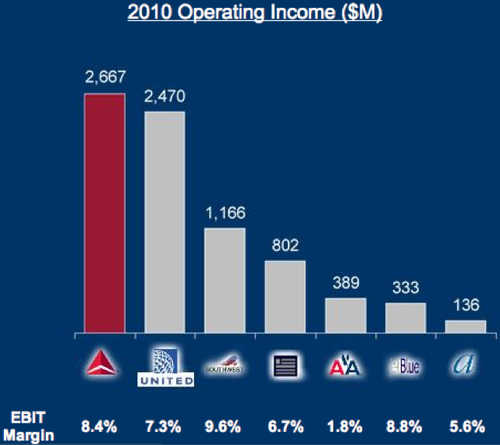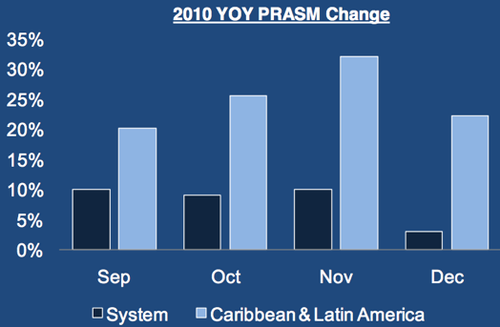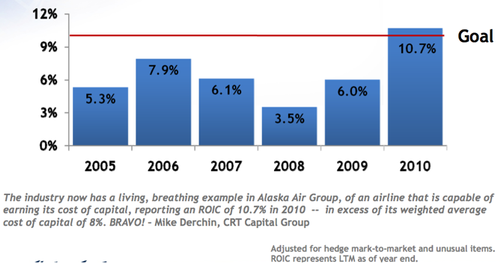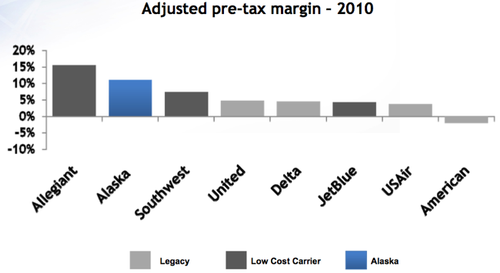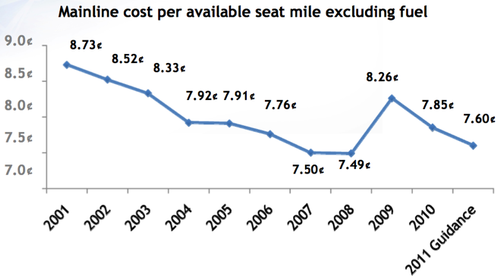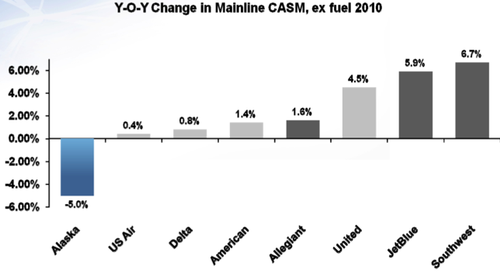US airlines report USD2.9bn profit, but not the whole story
US legacy and low-cost airlines have posted industry-wide profits of USD2.9 billion for 2010, a remarkable turn around on 2009 when the legacies - American, Delta, United and US Airways - posted severe losses while low-cost carriers weathered the storm somewhat better.
- US legacy and low-cost airlines posted industry-wide profits of USD2.9 billion for 2010, a significant improvement from the previous year.
- The strong demand and revenue picture from 2010 continued into 2011, with traffic outpacing capacity by a significant margin.
- Winter storms caused the cancellation of 20,000 flights, resulting in weather-related costs of over USD600 million for airlines.
- The gap between legacy and low-cost carriers in terms of cost per available seat mile (CASM) narrowed in 2010, with legacy carriers showing better cost control.
- Barclays Capital predicted that US airlines would earn USD9 billion in operating profits in 2011, slightly higher than the previous year.
- Alaska Airlines stood out with its impressive financial performance, achieving record profits and becoming the first carrier to achieve a 10.7% return on invested capital (ROIC).
Southwest chairman and CEO Gary Kelly put the good news in perspective, though, when he said: "While 2010 was a very satisfying year, it was an upbeat end to what I think most would agree has been a lost decade for the airline industry."
US airline results summary table: 2010 vs 2009
|
2010 vs 2009 |
ALK |
AMR |
DL |
HA |
JBLU |
LUV |
UAL |
USAIR |
ALGT |
|
|---|---|---|---|---|---|---|---|---|---|---|
|
Profit |
38.5M down 71.4% |
251.1M vs 121.6M |
471M loss down 67.9% |
593M vs 1.2B loss |
110.3M vs 116.7M |
97M vs 61M |
459M vs 99M |
854M vs 718M loss |
502M vs 205M loss |
65.7M down 13.9% |
|
Op Revs USD |
2.6B up 11.9% |
3.4B up 14% |
22.1B up 11.3% |
31.7B up 13% |
1.3B up 10.7% |
3.8B up 14.8% |
12.1B up 16.9% |
34B up 18.9% |
11.9B up 13.9% |
663.6M up 18.9% |
|
Op Exp USD |
2.4B up 15.1% |
3B vs 2.7B |
21.8B up 4.5% |
29.5B up 4% |
1.2B up 13.3% |
3.4B up 14.6% |
11.1B up 10.2% |
32.1B up 12.5% |
11.1B up 7.6% |
558.9M up 28.3% |
|
ASMs |
24B up 3.3% |
24.4B down 5.6% |
153.2B up 1% |
232.6B up 1% |
10.1B up 4.4% |
34.7B up 6.7% |
98.4B up 0.4% |
253B up 1.1% |
85.8B up 0.9% |
6.2B up 14.6% |
|
LF |
81.4% up 1.6 pts |
83.3% up 4 pts |
81.9% up 1.2 pts |
83% up 1pt |
85.5% up 1.6 pts |
81.4% up 1.7 pts |
79.3% up 3.3 pts |
83.2% up 1.9 pts |
81.1% up 0.6 pts |
87.5% up 0.1 pts |
|
Yield cents |
12.03 up 7% |
13.58 up 2.3% |
13.36 up 8.7% |
14.11 up 12% |
13.33 up 4.4% |
12.07 up 6.8% |
14.72 up 10.8% |
14.20 up 15.2% |
15.04 up 11.2% |
8.21 up 6.2%* |
|
PRASM cents |
9.79 up 9.1% |
11.31 up 7.3% |
10.94 up 10.4% |
11.71 up 13% |
11.40 up 6.4% |
9.82 up 9% |
11.67 up 15.7% |
11.81 up 17.9% |
12.20 up 12.1% |
7.45 up 6.6%* |
|
CASM cents |
10.35 up 11.4% |
10.96 up 1.7% |
12.78 up 3.2% |
12.41 up 3% |
12.01 up 8.5% |
9.92 up 7.4% |
11.29 up 9.7% |
12.72 up 11.3% |
12.97 up 6.7% |
8.95 up 11.9%* |
|
CASM ex fuel cents |
6.75 up 5.8% |
7.85 down 5% |
8.84 down 3% |
8.27 flat |
8.83 up 3.2% |
6.71 up 5.9% |
7.61 up 5.8% |
8.65 up 3.6% |
9.27 up 1.1% |
5.05 up 1.6%* |
|
Anc/other revs USD |
264M up 4.7% |
253.2M up 22.5% |
2.4B up 5.3% |
3.6B up 5% |
155.1M vs 143.1M |
367M up 2.6% |
490M up 44.1% |
2.9B up 13.1% |
1.2B up 17.2% |
196M up 19.2% |
The turnaround is not the story, however. Last year has to be characterised by two things; the incredible discipline on holding costs in check despite strong headwinds and revenue increases which not only covered cost increases - at least for the legacies - but far surpassed them. To put the icing on the cake, this was done without adding a lot of capacity, given the fact, that except in a few strategic cases, capacity was at flat-to-modest growth, as promised.
And for sprinkles on top, the strong demand and revenue picture are continuing into 2011. In short, traffic is outpacing capacity by a long margin.
But, and it is a big but, winter storms have forced the cancellation of 20,000 flights. According to AirlineForecasts Managing Partner Vaughn Cordle, who estimates that each cancellation equals USD7000, that means the weather-related costs will be more than USD600 million. That is far more than the USD100 million estimated by airlines for the December storms during their fourth quarter calls and the USD150 million cost the airlines incurred in the early 2010 period.
Airlines return to profitability
The other story is how close in CASM the low-cost carriers are compared with their legacy counterparts. JetBlue's ex-fuel CASM came in at 6.71 cents, while Southwest was in the middle at 7.61 cents between the two other LCCs as AirTran's CASM ex-fuel reached 6.71 cents.
The lowest legacy CASM ex-fuel was Delta at 8.27 cents, while the highest was US Airways at a full dollar more. Industry Consultants Oliver Wyman pointed out that, in the third quarter, the gap between legacies and LCCs was the narrowest in seven years.
Oliver Wyman pegged CASM increases at 2.3% between the third quarters of 2009 and 2010. Meanwhile, LCC CASM was up 4.9% compared with legacy CASM at 1.7%. Ex-fuel legacy CASM actually declined by 1.7% compared with a 2.4% increase for LCCs.
For the year, legacies seemed to do a better job than LCCs in keeping cost increases down with legacies ranging from Alaska, down 5%, to a 3.6% increase in CASM ex-fuel at United. LCCs, on the other hand, were up 5.8% for AirTran and Southwest and 5.9% for JetBlue.
Barclays Capital, impressed with the industry's 2010 performance, predicted US airlines would earn USD9 billion in operating profits in 2011, slightly up from 2010. Then it tempered its remarks.
"The bad news is that one key cause of the profit boost is not likely to last long," it said. "This reporting season, chief executives have been quick to thrust their capacity management capabilities into the limelight. The industry's revenue per mile rose almost one-third in the last 12 months as 82% of seats on North America's planes carried paying passengers. That is a higher proportion than in any other region in the world, according to the International Air Transport Association, and was enabled by last year's meagre 3.5% increase in capacity, measured in available seat kilometres."
Analysts still impatient
Barclays and other investment houses, however, are impatient about capacity plans, citing them for downgrading airline stocks. Despite the low ASM growth last year, JP Morgan analyst Jamie Baker questioned industry discipline, saying that, despite all their protestations, airline managements are not showing much capacity discipline given fuel increases.
Management is not sanguine about capacity at all with most indicating during the recent earnings calls they are biased toward less capacity than more. They also indicated that should demand drop as a result of fare increases, the fares will stick and the capacity will drop. It is hard to recall a time in US airline history in which this was the case, not even in 2008. Historically, when demand recovered so did capacity. That indication about fares versus capacity from management puts us clearly in a new era.
Apparently, analysts want the industry to show it is serious and that is exactly what Delta did which earned it kudos. Between its earning call and last week's Raymond James investment conference, Delta pulled the capacity trigger, deciding to drop capacity plans for this year by 1-2 points for both the first quarter and the full year which had been guided just two weeks ago to 5-7% in the first quarter and 1-3% for the year. The first quarter decline to 3-5% results from storm cancellations and other initiatives related to the fuel spikes. It also pared its 2011 spending by USD300 million in order to boost cash flow from USD1.6 billion.
President Ed Bastion cited accelerating retirements including the complete elimination of the DC-9s by this time next year. Also set for retirement are the 26 Delta Connection Saabs along with 60 CRJ-100s over the next 12-18 months. "We have 100 aircraft above and beyond what has already been announced," he told investors. Analysts are keen to see other airlines follow.
The capacity discipline has given airlines something they have not generally enjoyed before - pricing power - and that is evident by their ability to raise fares last year and in the past few weeks. Yet another fare increase last week seems to be sticking despite the fact Southwest did not match it.
In addition, airlines have also been able to successfully impose fuel surcharges, which United CEO Jeff Smisek indicated was an easier sell than a fare increase. Even so, managements across the board indicated that they would depend on a fare solution to rising fuel coupled, again, by capacity actions.
Capacity holding firm
For the most part, legacies held the capacity line generally under 2% year-on-year. Two exceptions AirTran (up 3.3%) and Hawaiian (4.4%) posted modest gains on strategic ASM increases while JetBlue (6.7%) outpaced the industry taking advantage of the departure of US Airways and American at Boston and the Caribbean, respectively. At the Raymond James conference last week, JetBlue CEO David Barger said he wants to find another Boston-like opportunity. The bottom line is that the capacity increases at JetBlue that have outpaced GDP, were strategic and rational.
Beyond that, the capacity gains were outpaced by revenue gains. The modest capacity moves were met by double-digit revenue gains across the board with the exception of Alaska. Alaska's story is as remarkable on the upside as American's is on the downside.
Caribbean and Latin American have outpaced system average unit revenue growth at JetBlue
The double-digit revenue gains, however, were met with double-digit cost increases. JetBlue had a small margin on its costs. AirTran's cost increases far outweighed revenue gains which compounded what is perhaps the biggest concern for airlines: its profits dropped 71.4% year on year as costs rose 15.8%. Analysts would not speculate on what is going on at AirTran except to say that it is set to be acquired by Southwest with its shareholders scheduled to vote the proposal up or down on 23-March. Given that, it opted not to have an earnings call and was otherwise silent on the reason behind the dramatic profit drop.
Hawaiian's costs also outpaced revenue increases but it also launched its western expansion to Tokyo Haneda, followed by Incheon last month. United, US Airways and Delta revenues far outpaced cost increases with Delta leading the industry with a 13% revenue jump to a 4% cost increase. This, despite the fact, as Mr Bastion put it at the Raymond James conference, the airline suffers from a RASM deficit in New York compared with its peers. Thus, the reason for its investment in cabin upgrades.
The 10 carriers earned a whopping USD22.6 billion, up from USD7.8 billion in 2009 in ancillary/other revenue, signaling once again that without them, the industry would not be doing so well. Ironically, the carrier where bags fly free, Southwest, earned USD500 million in ancillary revenues, rising the most of any carrier at 44.1% year-on-year. JetBlue expects to increase ancillaries by 20% this year.
A tale of two airlines: American and Alaska
American, continued its loss streak, alone among the nine carriers, further testing the patience of investors. It should start delivering on the cost and revenue synergies from its trans-oceanic joint ventures this year but it was worrying that it changed expectations during its earnings call. It initially indicated that it would gain USD500 million from the trans-Atlantic joint business alone. However, when it announced the launch of the trans-Pacific joint business with Japan Airlines, it attributed the USD500 million to both joint businesses. Interestingly, this week, British Airways said the trans-Atlantic joint business would equal USD500 million in synergies and increased revenues. Someone is diverting from the talking points.
Still, American should be given its due. Despite its near half billion loss, it managed to narrow its loss by 69% from a USD1.5 billion loss in 2009 to USD471 million in 2010. That is pretty good considering it lost half a billion in a single quarter alone last year. Other metrics are also moving in the right direction. Operating revenues increased 11.3% while operating costs were headed into the negative territory. Capacity only rose 1% at a time when yield was up 8.7% and PRASM was up 14%. CASM dropped 0.2% and CASM ex-fuel declined 3%.
Then there is Alaska, the good news for which is unsurprising since it led the charge on adopting a new measure of success - return on invested capital - which the rest of the industry was slow to follow.
The good results prompted the airline to announce growth plans for 2012 and beyond through which capacity would grow 8-9%. Chairman Bill Ayer indicated that the results flowed from its 2003-launched 2010 plan. CFO Brandon Pedersen indicated the results for the year translated into a record 11.1% pre-tax margin bringing the 2010 ROIC to 10.7%, the first of any low-cost or legacy carrier to achieve that. He also noted 2010 was the first time since 1999 that Alaska reported profits in all four quarters.
"Historically, we lost money in the first quarter, made a little in the second quarter, made a lot in the third quarter and then hung on for dear life in the fourth quarter," he said, adding its 2010 plan was designed to smooth out those peaks and valleys and ensure profitability in all quarters. During the earnings call, Mr Ayer explained the carrier's growth strategy for the future is built on sustaining that.
Alaska's goal: generate an average 10% ROIC
"While we support industry efforts to balance supply with demand, we believe the most efficient operators should grow more than the industry average," Mr Ayer told analysts during the earnings call. "In contrast to flat domestic industry capacity since 2003, Air Group ASMs have grown 18%. At the same time we have reduced our non-fuel unit costs from 8.73 cents in 2001 to 7.85 cents in 2010. We are continuing that trend because, in my view, we are now in a permanently low-fare environment. With our new fleet order we have the option to grow 3-6% annually as long as conditions permit. But let me be clear, we will not grow if conditions don't permit it."
Alaska announced a 15-aircraft order for Boeing 737s starting in 2010, including 13 -900ERs for delivery in 2013 through 2014. The new aircraft will go into trans-continental and mid-continental markets as well as high-density west coast markets. Mr Ayer noted that Hawaii was a question mark when it launched its 2010 plan, but it now represents 15% of its flying, bringing it to a close second to United in terms of daily west coast departures. Alaska Air Group doubled its profit year on year.
Mr Pedersen went further during the Raymond James conference, saying its new CASM ex-fuel goal for this year was 7.60 cents and indicated it would keep falling with a target in the 6 cents-plus range.
"The good thing about our excess capital and meeting financial goals, is that now's the time to grow the business modestly," he told investors.
Alaska's strategy was greeted with approval by at least two analysts.
"If this type of performance does not justify modest growth, we don't know what does," analyst Hunter Keay with Stifel Nicolaus wrote after the earnings came out. "We believe ALK should be viewed through a different lens than most of its peers that tend to grow for the wrong reasons such as CASM reduction, mollification of labour, or market share gains," he added. "While 2011 capacity guidance of ~7% is unsettling at first glance, we extend the benefit of the doubt until results dictate a different approach."
Maxim Group analyst Ray Neidl agreed in terms never heard relating to the airline industry. "Alaska Air Group knocked the cover off of the ball ... exceeding all estimates by a wide margin," he wrote in response to the group's earnings. "2010 was a record year for the company in earnings and 2011 we expect will exceed that milestone."
Alaska, indeed, deserves the benefit of the doubt given the fact it led the industry into a new fiscal management era and transformed itself without bankruptcy.
Meanwhile, United's impressive performance may not be all it is cracked up to be, especially when compared with Delta, according to analysts, who cited Delta's production of USD52 million in free cash flow in 4Q2010. United, on the other hand, did not discuss free cash flow in its release, despite the fact it did in its third quarter release. What disturbed the street was the drop in liquidity to USD8.7 billion in the fourth quarter, down USD400 million from the third quarter.
Fuel dampens relief at industry profits
One could well say that the industry is out of the woods and taking full advantage of a recovery that has been stronger than the broader economy, given the ability to raise fares last year and, in the last few weeks, raise them several times as well as impose fuel surcharges. That, of course, is thanks to the capacity discipline which is paying off as legacies held the line generally under 2% year on year.
The stage was set by Delta this year when it said that it expected a USD1 billion increase in fuel threatening its profitability plans this year. Even so, Mr Bastion told Raymond James attendees that the carrier has in its sites sustainable profitability, ROIC between EBITDAR 10-12%, which it missed this year by only two points, and getting the business over USD5 billion EBITDAR.
If airline managements are prepared for fuel, it is interested to see the differences in their strategies. US Airways, which sees hedging as far too expensive, and Allegiant prefer to address fuel hikes by steep capacity cuts. JetBlue and Alaska continue to hedge but are replacing older aircraft to more fuel-efficient equipment - the 737 in Alaska's case and a combination of the A320 and Embraer E190 at JetBlue.
For the most part, the airlines seem to be treating their hedging as insurance against volatility rather than trying to make - or at least not lose - money on it. Still, those at the Raymond James conference seem to indicate that consuming less was their best weapon.
At least one analyst, Mr Keay, wants airlines to abandon hedging in favour of fuel surcharges, citing the success of freight carriers UPS and FedEx.
"If this industry all stopped hedging, there would be a much more rational pricing environment," Mr Keay said. "It would be a landscape that would be far more conducive to fuel surcharges and would save airlines hundreds of millions of dollars in expense."
That boosts US Airway's strategy which ended fuel hedging in 2008. "We think it remarkable that we had the lowest economic fuel price of any airline in the fourth quarter especially since we didn't hedge," said President Scott Kirby. "We believe the cost of hedging remains exorbitantly expensive and if we did it through call options it would cost us about USD330 million assuming 100 per cent of full year's production and market prices higher than today's. It is hard to rationalise when the cost of insurance is so incredibly expensive. It is hard for us to understand how to make a systematic hedge programme work."
Aircraft orders tempered
Movement on aircraft orders is worrying investors, according to analysts, fearing that history is repeating itself ordering as the cycle rises but taking delivery when the cycle is in the opposite direction. They cite Delta's recent RFP to worldwide manufacturers as well as Alaska's order and the capacity plans for JetBlue.
Delta made it clear, however, with no order book - something it was quick to point out benefited the balance sheet - it was completely flexible. It does, however, recognise there will come a point in fuel costs when increasing fuel efficiency will not be an option. Thus the reason for beginning the RFP process.
Delta was also quick to point out at the Raymond James conference that most of its merger costs were behind it while United is at the front end of its merger with Continental. In addition, Southwest's merger with AirTran remains unapproved either by Washington or AAI shareholders. Even so, analysts expressed disappointment in the overall merger contribution and suggesting the promised synergies have not materialised at Delta and questioning whether United will actually realise its promised synergies.
Delta sets the pace and challenges for labour
Delta is also ahead of the game in terms of labour, Mr Bastion pointed out. The carrier has undergone no less than six representation votes since its merger with Northwest and employees opted overwhelming for a direct relationship with management.
"This was the largest union drive in history except for Ford," he told investors. "This is strategically important because it provides us with an opportunity to work directly with employees and provides us with a stable and predictable labour costs. All our employees have been brought to industry standards. There will be no labour cost escalation. We've taken labour risk off the table."
Its success, however, may mean more activity at other carriers. "The losses at Delta will make the unions hungry for increased membership and recent changes to federal election law under the Railway Labor Act make it easier for unions to win a secret ballot election," said MIT Research Engineer Bill Swelbar looking ahead to labour in 2011. Unions are already targetting JetBlue and will make yet another attempt at SkyWest. SkyWest focusses on employee relations but the new election rules coupled with pilot ruminations about President Chip Childs could make the difference.
The rest of the pack, except perhaps Southwest, continue to struggle with labour although there are some silver linings, Mr Swelbar said. He indicated that electing Delta Captain Lee Moak to lead the Air Line Pilots Association should lead to a more reasonable labor management relationship. He also wondered in a recent blog about what he detects may be a fundamental change in flight attendant philosophy given Delta's wins. He noted the flexibility and productivity built into the Delta relationship gained in exchange for industry leading pay.
He questioned, however, whether that would be adopted at other airlines, noting the more-productivity-for-more-pay philosophy has worked for Southwest and Continental and suggested American flight attendants, represented by the Association of Professional Flight Attendants should follow suit since American is suffering from higher labour costs. American's contract, he said, puts flight attendants at or near or at the top of the scale while productivity is near the bottom compared with peers.
"In many old-line agreements, aircraft technology (flying longer and faster) is the driver behind the work rules," he wrote. "This technology - more advanced aircraft that could fly more passengers faster and farther - created a false perception that employee productivity was increasing. Today there is little to no technology effect on flight crew productivity. And it's high time that contract agreements reflect that reality."
Despite that, he suggests APFA is instead asking for more pay without offering anything in return.
"If the Delta vote is a referendum on the former Northwest employees not being content with their union, might there not be opportunities for the International Brotherhood of Teamsters to begin raiding select work groups," Mr Swelbar asked, adding that labour will be a significant story this year. "There is new leadership at the Air Line Pilots Association; the Allied Pilots Association; and the AFA-CWA to name a few. While it is hard to predict whether things will change at the largest flight attendant union, AFA-CWA, after multiple terms under Patricia Friend, I am confident that changes in leadership will benefit the pilots represented by both ALPA and the APA."
As for American, the battle, he says is more about expectations versus reality. "The unions have so far been unwilling to reconsider contract language and provisions not even relevant to today's industry," he concluded. "There are no more magic bullets like the jet airplane coming along to artificially inflate employee productivity. The only way to get there is to rethink dated notions of productivity and job protections. And that's a real opportunity, for labour and for management."
As for the increasing politicisation of the National Mediation Board, Mr Swelbar says the jury is still out on whether it will become more political still. He pointed out this year's agenda includes American, United/Continental and weighing in on the charges Delta interfered with elections for the International Association of Machinists and Association of Flight Attendants.
One of the least unionised workforces, Delta will be the one to watch, according to Mr Swelbar. "The hard work is just now beginning at Delta," he said. "It won't be that long until another election can be called. And the difficulty of the task is highlighted by the civil war between the work groups at US Airways that continues into yet another year. It seems unlikely that the legal issues dividing the merged pilot groups and pilots and management are near resolution. All eyes will be on United CEO Jeff Smisek and Southwest CEO Gary Kelly to see how they manage culture change at their bigger, more complex carriers."
Mr Swelbar concluded that the industry will experience more organising activity in any event.
Scope issues
The big issue in the United-Continental relationship is, of course, scope and keeping jobs at the mainline. The outcome of this issue will weigh on the regional airline sector. Interestingly, the US Airways pilots organised recently to create the US Airways Express Pilots Alliance (USEPA). Clearly, ALPA is split between the interests of mainline pilots and regionals which are not the same.
USEPA will address issues of "Express-level" pilots at the seven airlines in the USAirways brand. But many of these issues supersede a single airline as so aptly illustrated by the fight between United, Continental and their respective Express counterparts.
While citing safety and improving pilot contract standards within the brand, protecting jobs, is of course, of paramount importance and a good thing too given the inflammatory rhetoric coming from Continental Master Executive Council Chair Jay Pierce and his counterpart at United Wendy Morse.
The USAirways alliance, said the group, would make each pilot group more effective in safety, security, collective bargaining and job preservation for the 4000 pilots at Air Wisconsin, Colgan, Mesaba, Mesa, Piedmont, PSA and Trans States airlines.
A single quarter does not make a recovery...
Often repeated last year is the fact that a single quarter does not make a recovery in the airline industry. The same can be said about a single year. Management are all on the same page about capacity and the necessity to shed it as fuel rises. They are also on the same page about recovering the fuel increases from passengers. The question is what will happen as fares rise. Only fares and load factors in the coming months will produce that answer.
